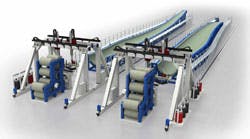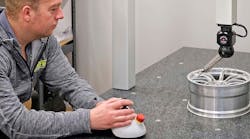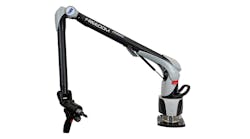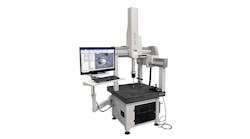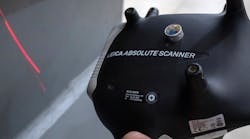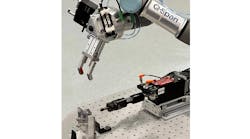MAG Industrial Automation Systems says its Rapid Material Placement System (RMPS) is "an automated blade molding facility unto itself, capable of spraying in-mold coatings, dispensing/lay-up of glass and carbon fiber materials, and dispensing/application of adhesive."
Fabricating spars, beams, stringers, and similar components is faster and more consistent thanks to a MAG’s new Flat Charge Laminator machine.
In the realm of public policy, "wind energy" has gone from the "next big thing" to "current craze," to "controversial issue" in less than two years: the current controversies over the consuming market’s acceptance of wind-generated electricity, as well as the political tempest over mandating domestically sourced materials and components, overshadow the real progress made by manufacturers to ready themselves for the particular demands of machining and fabricating wind turbines and windmills.
But, in the technological realm, it’s been a different story. Manufacturers of windmill components and products have aggressively developed capabilities and capacity to serve the emerging demand. And, the OEMs and shops producing those components and products have relied on new and newly available technologies to do the job. It hasn’t been altogether easy.
For example, there is the obvious challenge of manufacturing oversized, precision components, like windmill blades. Among machine tool builders, MAG Industrial Automation Systems is staking out a specialty in the field of composite blades: in recent months it has introduced two patent-pending technologies — the Rapid Material Placement System (RMPS) and a quick-cure molding system for wind blades — which it says reduce labor requirements by two-thirds, double product throughput, and produce a consistently high-quality blades.
Rapid manufacturing
The RMPS integrates manufacturing for what normally has been a manual or "piecemeal automated" process. RMPS automates blade molding: spraying in-mold coatings, dispensing/lay-up of glass and carbon fiber materials, and dispensing/application of adhesive.
Production is accelerated, too. It speeds the lay-up process (placing materials in blade skin, spar cap, and sheer web molds) to 3 m/sec, 10 ft/sec, using laser- and vision-based wrinkle detection in cross or longitudinal directions. MAG says RMPS can reduce lay-up time by 85 percent on a 45-m blade, depending on the laminate schedule.
The CNC-controlled production system is programmed off line. It’s designed as a gantry system with multi-axis end effectors capable of manipulating spray heads and adhesive applicators, as well as tooling for spooling and placing materials. After applying gel-coat with spray-head tooling, a ply-generator with a 10-roll magazine of material cuts and dispenses plies to the lay-up end effector on the gantry. The lay-up end effector spools up the material supplied by the ply generator. As the fabric is paid out onto the mold, a pair of articulating powered brushes smoothes it to the tool surface.
The lay-up system is mechanically repeatable to ±2 mm, with application tolerance of ±5 mm.
MAG says a shop operating two RMPS gantry systems side by side can produce a 45-meter blade-shell half in less than two hours, with half the manual labor of conventional methods. The gantry system rides on rails that are flush with the floor. It also carries bulk supply systems for gel-coat and adhesive.
Fast lay-up
Similarly, MAG recently introduced a Flat Charge Laminator machine for high-volume "lay-up" of composite spars, beams, stringers and similar wind-blade components. It’s a system designed for repeatability, so users may expect lower labor costs with higher quality finished parts, more product consistency, and overall improvements in productivity.
The servo-controlled design features four heads dedicated to four different materials. The machine produces constant- or variable-thickness laminates on a segmented vacuum table, compacting the layers with a force of 13.6 to 136 kg (30-300 lb). The FCL handles 0/90 prepreg fabric, +/- 45 prepreg fabric, unidirectional tape and, as an option, foil or film. Maximum material width is 300 mm / 12 in. on rolls up to 635 mm / 25 in. diameter, and weighing up to 150 lb.
The FCL has four servo-controlled dispensing heads on a placement carriage that moves on rails integrated with the vacuum bed. The servo-powered placement carriage is driven by a rack-and-pinion system.
Production processes are controlled by a Siemens PLC, with rotary and linear encoders on the dispensing heads and placement carriage for speed and position feedback. Servo-driven supply reels are protected with a magnetic clutch override, and the backing paper take-up system is torque controlled.
Quick cure
Also, MAG developed a patent-pending quick-cure mold system that uses tooling MAG also will supply. Molds are produced using the blade designer’s or the operator’s own CAD data. With each cycle, the system produces a finished blade to spec. It can be infused with resin in an hour, followed by a two-hour cure, which is about half the normal curing time.
In operation, this system has produced parts representing a 100 mm-thick root section and root spar cap system with three zones of material and three thicknesses. It demonstrates that the system can infuse and cure all three zones at the same time quickly.
Like the RMPS lay-up system, the infusion/curing system includes process control metrics for resin metering, temperatures, blocked channels, etc., with alarm limits.
Finishing up
For fabricating blades once they’re produced, MAG introduced a 5-axis system — Agile Gantry Multi-Processing — for machining and finishing for windmill blades; similar oversized parts, such as boat hulls and aerospace components, are other possibilities. The machine has unlimited X-axis range, 40 m/min traverse speed, automatic tool change, and five servo-controlled axes.
The Agile Gantry is a CNC machine-tool platform that offers five-sided part access, so it supports various applications and production processes. This includes cutting tools, spray heads, water-jet cutters, chopper guns, and finishing tools. MAG indicates it can be used to produce complex mold geometries in high-density foam, apply coatings, or trim and finish free-form contoured parts.
It’s designed to use a modular rail system to create any X-axis length required. The rail system can be installed below the factory floor, above it, or elevated in a high rail configuration.
Numerous workholding systems can be adapted and positioned between the rails. The gantry cross rail provides 5.5 m / 18 ft of Y-axis travel and 2.5 m/ 8.2 ft (or greater) of Z-axis reach. Servo-controlled contouring is simplified with rotary A and C axes (spindle tilt and wrist roll) that provide ±100° and ±200° of movement, respectively.
Maximum feed rate for the linear X, Y, and Z axes is up to 40,000 mm/min (0.004 to 1,574 ipm), and up to 3,600 degrees/min in the rotary axes. Linear axes are powered by dual electronically preloaded, AC servomotor rack-and-pinion drive systems.
The machine's 15-kW / 20-hp AC spindle is liquid-cooled and delivers a 0-24,000 rpm speed range. It accommodates an HSK63F tool shank. A high-capacity vacuum system captures dust and chips. A drum-type tool changer holds 16 tools for automatic tool changes.
Machine control is provided by a Siemens 840D CNC with color screen, handheld pendant, and hand wheel controls.
